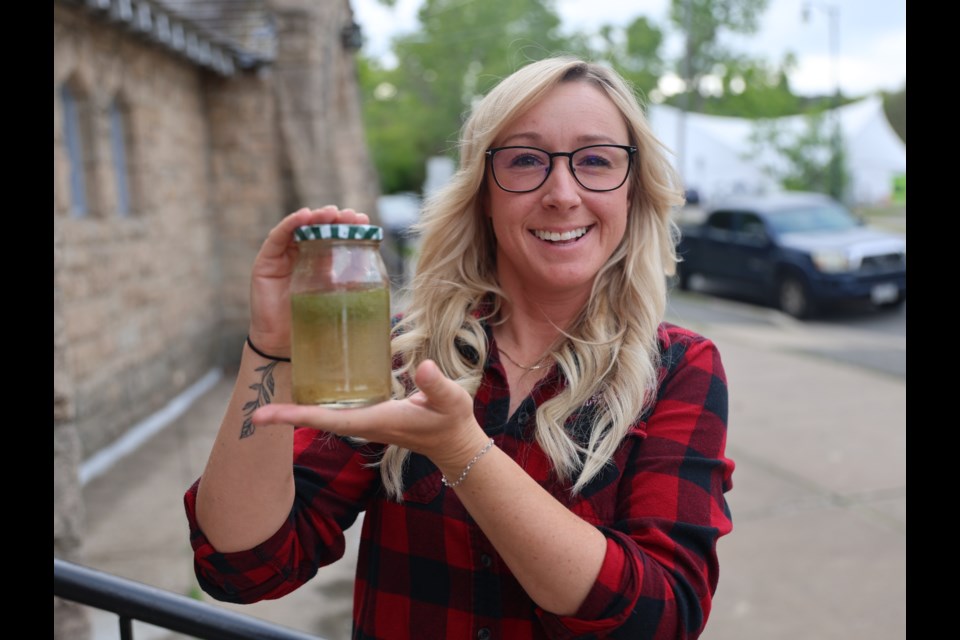THUNDER BAY — Planting native vegetation along lakefronts is one relatively simple way conservation experts say property owners can mitigate potentially toxic blue-green algae blooms.
Plants like red osier dogwood, common ninebark, swamp milkweed and many others, not only beautify the shoreline and have other environmental benefits, but also help filter runoff into lakes — that runoff can contain the nutrients that help the algae thrive, said Lakehead Region Conservation Authority environmental planner Michelle Willows.
“When we have these big rain events, you're having the water rush in, there's stormwater coming into the (lake) water and it's carrying lawn clippings, it’s carrying fecal matter from geese,” she said.
“It's causing all this nutrient loading, so we're trying to address that with the shoreline plantings.”
The conservation authority was one of three presenters at a public meeting Thursday evening at Trinity United Church about blue-green algae, also called cyanobacteria, and ways people can help stop it from thriving further. Willows said the conservation authority itself has had success with shoreline planting.
“At Mission Island Marsh, you may have already noticed that in 2021 we implemented shoreline plantings,” she said.
“And then we even put more plants in in 2023 because we found it to be so successful for not only mitigating shoreline erosion, but it was really good for water quality there.”
Willows said, based on that success, the LRCA has also started a similar project at its Hazelwood Lake site, as that conservation area is prone to annual blue-green algae blooms.
“The beach itself is right adjacent to a big open field, so we're looking at adding some native vegetation and restoring that buffer zone,” she said.
The goal, Willows added, is to “address the cyanobacteria issues that we're having so that people can come and visit and swim without worry.”
The toxins found in cyanobacteria can pose numerous problems, according to an LRCA fact sheet on blue-green algae, including causing respiratory and gastrointestinal illnesses and skin irritations. It is also toxic to pets, wildlife and livestock and its presence reduces oxygen in the water, which hurts aquatic plants, fish and other marine life.
“Each toxin has varied acute health effects and the extent of exposure will influence the severity of the symptom,” the LRCA’s fact sheet said. “Not all toxins are present in a cyanobacteria bloom — only lab testing can determine the toxin present and the amount.”
Thursday’s forum was organized by Trinity and St. Paul’s United Churches and the Loon Lake Waterkeepers Conservancy, a group focused on water quality in the popular lake located northeast of Thunder Bay. It also heard from Nathan Wilson, a water quality researcher at Lakehead University who specializes in cyanobacteria.
More instances of blue-green algae blooms have been reported largely in inland lakes in recent years.
Wilson’s presentation talked about the naturally-occurring bacteria’s life cycle and how human impact has helped oversaturate lakes with the nutrients that allow it to thrive, including phosphorus and nitrogen.
While there are some solutions that work in confined environments, like aquariums, he said, they tend not to work or be practical in larger ecosystems, like lakes.
Wilson and Willows said that, aside from improving shoreline filtration through planting, other things people can do to mitigate algae blooms is to reduce the amount of these nutrients that enter the lakes by using no-or-low phosphorus fertilizers and phosphate-free soaps and detergents — especially if one’s sauna is right by the lakeshore, Willows added.
Making sure septic systems are functioning properly and not leaching into the lake is also very important.
Keeping these things in mind is important, Willows said.
“If you're at a camp and you spend all your time at camp and now it's hot and 30 degrees and you can't go in the water because there's cyanobacteria and you're worried about getting sick, that's not ideal,” she said.
“Not only are we looking to improve the water quality of the watershed just for natural and nature-based reasons, we're also trying to protect the residents so that they can enjoy where they live and our watershed itself.”
